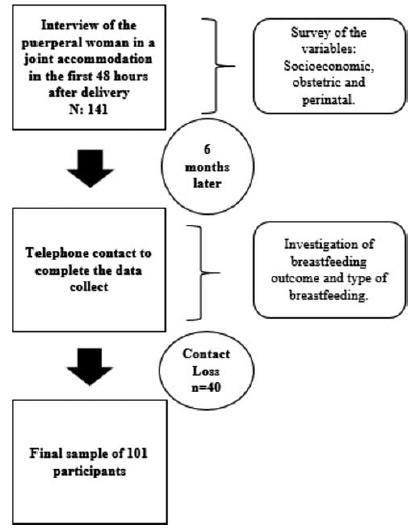Summary
Revista Brasileira de Ginecologia e Obstetrícia. 2021;43(2):91-96
01-19-2021
To analyze the factors associated with the prevalence of exclusive breastfeeding (EBF) for up to six months in mother/infant binomials cared for at a usual-risk maternity hospital.
The present is a descriptive, longitudinal, prospective, quantitative study. Socioeconomic, obstetric and perinatal variables from 101 mother/infant binomials in a Public Maternity Hospital in the city of Curitiba, state of Paraná, Brazil, were investigated during hospitalization after delivery and 6 months after birth. For the statistical analysis, the Chi-squared test was used. The variables that showed values of p < 0.25 for the Chi-squared test were also submitted to an odds ratio (OR) analysis.
The prevalence (42.6%) of EBF was observed. Most women (93.1%) had had more than 6 prenatal consultations, and the variables maternity leave and support to breastfeeding were associated with EBF. Support to breastfeeding by professionals and family members increased 4-fold the chance of maintenance of EBF (OR = 0.232; 95% confidence intercal [95%CI]: 0.079 to 0.679; p = 0.008). Cracked nipples were the biggest obstacle to breastfeeding, and low milk production was the main responsible factor for weaning.
The encouragement of breastfeeding and the mother’s stay for a longer period with the child contributed to the maintenance of EBF until the sixth month of life of the infant.

Summary
Revista Brasileira de Ginecologia e Obstetrícia. 2012;34(1):28-33
02-17-2012
DOI 10.1590/S0100-72032012000100006
PURPOSE: To describe the characteristics of mothers and children and to evaluate the factors associated with discontinuation of exclusive breastfeeding. METHODS: A cross-sectional study on infants under six months of age who attended the vaccination campaign in 2008. In the sample design, vaccination units were selected by drawing lots and infants were similarly selected later at each unit systematically. A semi-structured instrument was used for data collection, containing questions about children's nutrition and socio-demographic characteristics. We used Odds Ratio and the χ² test for data analysis, accepting as the critical level p<0.05. RESULTS: The prevalence of breastfeeding for infants under 120 and 180 days of age was 89.5 and 85% respectively, and exclusive breastfeeding was 50.6 and 39.7% for infants less than 120 and 180 days of age, respectively. The factors most related to the abandonment of exclusive breastfeeding in infants under six months were maternal employment outside the home (OR=2.73; 95%CI=1.74-4.29) and use of pacifiers (OR=4.26; 95%CI=2.85-6.38). The mother being multiparous (OR=0.57; 95%CI=0.40-0.81) and receiving postpartum care in the public health care network (OR=0.55; 95%CI=0.39-0.79) represented protective factors against the practice of early cessation of breastfeeding. CONCLUSIONS: The prevalence of breastfeeding and exclusive breastfeeding in the municipality of Uberlândia is among the highest in the country and the factors most often associated with the practice of early weaning were maternal employment outside the home, offering pacifiers to the infants, receiving postpartum care in the private health sector, and primiparity.